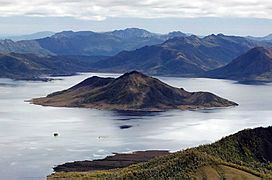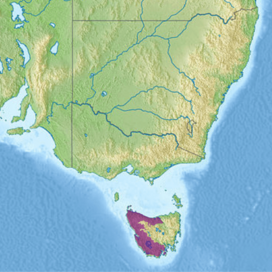Tasmanian temperate rainforests facts for kids
Quick facts for kids Tasmanian temperate rain forests |
|
|---|---|

|
|

Ecoregion territory (in purple)
|
|
| Ecology | |
| Realm | Australasian |
| Biome | temperate broadleaf and mixed forests |
| Borders | Tasmanian Central Highlands forests and Tasmanian temperate forests |
| Geography | |
| Area | 31,340 km2 (12,100 sq mi) |
| Country | Australia |
| States | Tasmania |
| Conservation | |
| Conservation status | Vulnerable |
| Protected | 16,649 km² (50%) |
The Tasmanian temperate rain forests are a special type of forest found in western Tasmania. These forests are part of a larger natural area called an ecoregion. This ecoregion belongs to the Australasian realm. This realm includes Tasmania, Australia, New Zealand, New Guinea, New Caledonia, and other nearby islands.
Rainforests in Australia are known as "closed forests." This means their tree tops cover 70–100% of the ground. There are different kinds of rainforests, like tropical and subtropical. The Tasmanian rainforest is called cool temperate rainforest. It is the most diverse and developed cool temperate rainforest in Australia.
You can find these forests in different parts of Tasmania. They are in the West, Savage River National Park, South West, North East, and some patches on the East Coast. Unlike mainland Australia, Tasmania has fewer types of large woody trees. But it has many smaller plants like mosses, liverworts, lichens, and fungi.
Because of this, the definition of Tasmanian cool temperate rainforest changed in the 1980s. Now, it includes forests where trees are usually taller than 8 meters (26 feet). These trees can also grow back on their own without big disasters like fires. These forests are "climax vegetation." This means they are stable and have reached their final stage of growth.
They are mostly filled with flowering plants (angiosperms) like Nothofagus cunninghamii (myrtle beech), Atherosperma moschatum (sassafras), and Eucryphia lucida (leatherwood). There are also cone-bearing plants (gymnosperms) like Athrotaxis selaginoides (King Billy Pine), Lagarostrobos franklinii (huon or macquarie pine), and Phyllocladus aspleniifolius (celery-top pine). Scientists think the small number of woody species is because of many past ice ages.
Tasmanian cool temperate rainforests are divided into four main types. These are Callidendrous, Thamnic, Implicate, and Open Montane rainforests. Each type has different features. They vary in how they look, the plants they contain, where they grow, and how many unique species they have.
Contents
Types of Tasmanian Rainforests
Tasmanian cool temperate rainforests are grouped into two main plant families. These are the myrtle-beech (Nothofagus cunninghamii) family and the pencil pine (Athrotaxis cupressoides) family. The myrtle-beech group includes Callidendrous, Thamnic, and Implicate types. The pencil pine group is only the Open Montane type.
Callidendrous Rainforest
This is the simplest type of rainforest in Tasmania. It has medium to tall trees, often over 40 meters (130 feet) high. These forests are usually dominated by Nothofagus cunninghamii and/or Atherosperma moschatum. Other trees like Leptospermum lanigerum (woolly tea-tree) or Acacia melanoxylon (Australian blackwood) are also common.
The trees are usually well-shaped and spaced out. The understorey (plants growing below the main trees) is open, almost like a park. There are not many types of woody plants in the understorey. However, at lower elevations, you might find small trees or shrubs. Examples include Olearia argophylla (musktree) and Pittosporum bicolor (cheesewood).
Many types of ferns grow here. Epiphytes (plants that grow on other plants) are also common. The main tree ferns are Dicksonia antarctica (soft tree fern) and Polystichum poliferum (mother shield fern). Common epiphytes include Rumohra adiantiformis (leathery shieldfern) and Microsorum diversifolium (kangaroo fern).
As you go higher up the mountains, the forest gets shorter. Nothofagus cunninghamii trees become crooked and have many mosses and lichens growing on their trunks. The understorey changes to plants like Tasmannia lanceolata (mountain pepper) and Telopea truncata (Tasmanian waratah). Fewer types of ferns grow at higher altitudes.
Callidendrous rainforests are found in the eastern, northwestern, and central parts of Tasmania.
| Species found | %Cover | Type/form |
|---|---|---|
| Atherosperma moschatum | >75 | Dominant species |
| Histiopteris insica | 1 | Understorey |
| Dicksonia antarctica | 5 | Understorey |
| Chiloglottis cornuta | 1 | scattered |
| Corybas diemenicus | 1 | scattered |
| Clematis aristata | 1 | scattered |
| Comprosma quadrifida | 1 | scattered |
| Hymenophyllum australia | 1 | scattered |
Table 1: This table shows some plants found in a mixed Callidendrous and Thamnic rainforest. This forest is about 20 meters (65 feet) tall. The ground is mostly covered with leaf litter.
Thamnic Rainforest
Thamnic rainforests have well-shaped trees that are not as tall, usually below 40 meters (130 feet). They have a clear layer of shrubs. The main trees are a mix of 2–5 species. These often include Nothofagus cunninghamii, Eucryphia lucida, Atherosperma moschatum, and Lagarostrobos franklinii.
The shrub layer is much thicker and has more types of woody plants. Common shrubs include Anopterus glandulosus (Tasmanian laurel) and Anodopetalum biglandulosum. The many gaps in the tree canopy allow more light to reach the shrubs. This helps different species grow.
There are fewer types of ferns here because of less light. Parablechnum wattsii (hard water fern) is the main ground fern. It likes damp, shady spots. Small epiphytes like Hymenophyllum rarum (a filmy fern) are common. At higher altitudes, Thamnic rainforests can look like Callidendrous ones, but their plant types are still different.
Thamnic rainforests are mostly found in western and southwestern Tasmania.
| Species | % cover | Type/form |
|---|---|---|
| Blechnum nudum | 1 | ground cover |
| Anodopetalum bilandulosum | >75 | Understorey |
| Anopteris glandulosa | >50 | Understorey |
| Nothofagus cunninghamii | >75 | Dominant |
| Atherosperma moschatum | >75 | Dominant |
| Eucryphia lucida | 20 | Understorey |
| Phyllocladus asplenifolius | 5 | shrublayer |
Table 2: This table shows some plants found in a Thamnic rainforest. This forest is about 35 meters (115 feet) tall. The ground is mostly covered with leaves.
Implicate Rainforest
Implicate rainforests are shorter, usually less than 20 meters (65 feet) tall. Their tree tops are broken and uneven. Many different tree species share dominance here. These include Nothofagus cunninghamii, Nothofagus gunnii, Eucryphia lucida, and Atherosperma moschatum.
The understorey is very tangled and hard to tell apart from the main tree layer. It can form a continuous layer from the ground to the tree tops. There are many types of trees and shrubs in this community, but very few types of ferns. Common shrubs include Anopterus glandulosus and Richea pandanifolia.
The main fern is Parablechnum wattsii. Small epiphytes like Hymenophyllum rarum are also present. These forests are mostly found in western and southwestern Tasmania.
Open Montane Rainforest
This type of rainforest is low-growing. It is mostly dominated by Athrotaxis cupressoides or Athrotaxis selaginoides trees. The tree canopy is open, with trees spaced far apart. This allows a lot of sunlight to reach the lower parts of the forest. Sometimes, the canopy can be dense, looking like a high-altitude Callidendrous forest.
The understorey might be covered by grasses (Poa) or mosses (Sphagnum). It can also have low shrubs that are less than half the height of the forest. There are many types of woody plants but few types of ferns. Shrubs include Nothofagus cunninghamii, Nothofagus gunnii, and Richea pandanifolia.
Ferns are usually not well developed here. Larger ground ferns are rare or only found on rocks. Gleichenia alpina is an exception. Small ferns like Hymenophyllum peltatum can sometimes appear. These forests are found on the Central Plateau and in mountains further south.
How Geology Affects Rainforests
The type of rocks and soil in Tasmania greatly affects its forests. Callidendrous forests need good quality sites. They grow on fertile soils found over rocks like basalt, dolerite, and nutrient-rich granites. Implicate forests are the opposite. They mostly grow in organic soils or mineral soils from poor rock types like quartzites. Thamnic forests prefer soils that are somewhere in between. Except for open montane forests, altitude does not seem to change the plant types much.
Protecting These Forests
In 1982, the United Nations Educational, Scientific and Cultural Organization (UNESCO) named the northern part of this ecoregion a World Heritage Site. This means it is a very important place that needs to be protected for everyone.
Protected Areas
Many areas within this ecoregion are protected. This helps keep these unique rainforests safe. Some of these protected areas include:
- Franklin-Gordon Wild Rivers National Park
- Hartz Mountains National Park
- Meredith Range Regional Reserve
- Mount Dundas Regional Reserve
- Narawntapu National Park
- Savage River National Park
- Southwest National Park
- West Coast Range Regional Reserve



